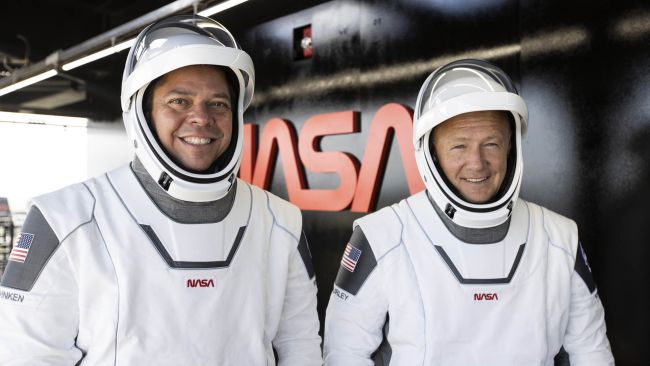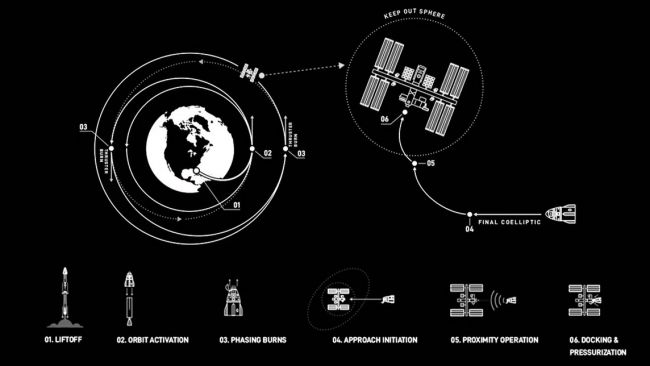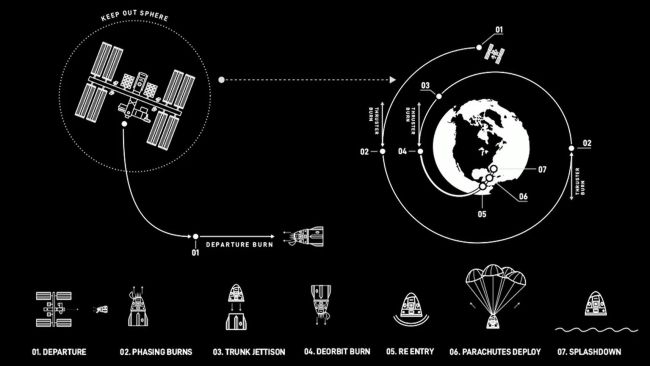
The first SpaceX Crew Dragon spacecraft to carry astronauts successfully docked with the International Space Station today, May 31, at 10:16 a.m. EDT (1416 GMT) after a successful launch into orbit yesterday. See our full coverage of the historic mission below.
Elon Musk’s space company is flying its first crewed mission, a test flight called Demo-2 to send NASA astronauts Bob Behnken and Doug Hurley to the International Space Station on a Crew Dragon capsule. It lifted off from Pad 39A of NASA’s Kennedy Space Center in Florida.
What’s Crew Dragon?
SpaceX’s Crew Dragon is a crewed spacecraft designed to fly astronauts on round trips to the International Space Station for NASA.
In 2014, NASA picked SpaceX as one of two companies (Boeing was the other) to fly astronaut taxi missions to the space station. Crew Dragon is a crewed version of SpaceX’s Cargo Dragon spacecraft, an unpiloted vehicle that has been making resupply flights to the station for NASA since 2012.
SpaceX’s Crew Dragon will carry up to four astronauts on regular taxi trips, but the capsule itself can fit up to seven people in all. It launches into space on a Falcon 9 rocket, SpaceX’s workhorse booster.
Both vehicles are reusable, with SpaceX regularly landing Falcon 9 first stages and flying them later. SpaceX has also reused several Dragon cargo vehicles and aims to do the same with Crew Dragon.
Unlike Cargo Dragon, the Crew Dragon spacecraft has an emergency abort system designed to separate the capsule from its rocket in the event of a launch emergency. SpaceX demonstrated that system in a successful test earlier this year.
Crew Dragon’s service module has a series of sleek fins, as well as solar arrays mounted directly to its hull, rather than in deployable panels like its cargo-only counterpart.
Who’s flying?
As odd as it may seem, Crew Dragon has two commanders.
The crew for Demo-2 are veteran NASA astronauts Bob Behnken and Doug Hurley. Behnken will serve as the mission’s joint operations commander while Hurley is Crew Dragon spacecraft commander. Both men have flown to space multiple times. Click here for more Space.com videos…
Robert “Bob” L. Behnken, 49, has flown two space shuttle missions to the International Space Station and served as NASA’s Chief Astronaut from 2012 to 2015. He launched on the STS-123 mission to deliver Japan’s Kibo laboratory to the station in 2008, and later flew STS-130 on Endeavour to deliver the Tranquility module. Behnken has performed six spacewalks and logged more than 29 days in space to date.
A native of St. Ann, Missouri, Behnken is a U.S. Air Force colonel and test pilot with a doctorate from Caltech in mechanical engineering. He joined NASA’s astronaut corps in July 2000.
Behnken is married to Megan McArthur (also a NASA astronaut). They have one son. You can follow Behnken on Twitter at @AstroBehnken.
Douglas G. Hurley, 53, is retired U.S. Marine Corps colonel who joined NASA’s astronaut corp in 2000 in the same class as Behnken. Hurley has flown on two shuttle missions, the STS-127 mission on Endeavour in 2009 and the STS-135 mission on Atlantis in 2011. Both missions hauled fresh supplies and gear to the station. Hurley’s second shuttle flight was NASA’s final mission of the space shuttle program.
Hurley hails from Apalachin, New York and served as a pilot and test pilot for the U.S. Marine Corp. He has degree in civil engineering from Tulane University in Louisiana and is married to fellow NASA astronaut Karen Nyberg. They have one son. Hurley has logged just over 27 days in space. You can follow him on Twitter at @Astro_Doug.
How it gets to ISS

On Demo-2, SpaceX’s Crew Dragon will take about 19 hours to reach the International Space Station.
After liftoff, it will take Crew Dragon about 12 minutes to reach its initial orbit. The first stage of its Falcon 9 rocket will return to Earth to land on a drone ship for future reuse.
Crew Dragon will spend a dozen of so hours chasing the space station, gradually raising its orbit to the 250-mile (400 kilometers) altitude of the International Space Station.
If all goes well, Crew Dragon will dock itself to the space station on Thursday, May 28, at 11:39 a.m. EDT (1539 GMT). It will link up with docking port on the station’s Harmony module, with hatches between the two spacecraft at 1:55 p.m. EDT (1755 GMT).
While Crew Dragon is designed to dock itself autonomously, Hurley will take manual command of the spacecraft during the rendezvous to test the vehicle’s flight systems.
How long’s the flight?

This is hard to say.
NASA and SpaceX have not released an exact date for Crew Dragon’s return to Earth for the Demo-2 mission. But we do know the mission will last at least one month, and possibly up to four months. The exact duration will depend on a few factors.
First, the mission’s duration will depend on Crew Dragon’s performance with astronauts aboard. If the spacecraft performs as planned, then there wouldn’t be any engineering concerns on that end.
Second, the duration will also depend on Demo-2’s follow-up mission, called Crew-1, which will be SpaceX’s first operational mission to the space station for NASA. The Crew-1 Dragon spacecraft is being built now. It will launch four astronauts to the space station later this year.
One thing that is certain: Crew Dragon has an expiration date. The spacecraft’s solar arrays are currently only rated for 119 days in space. That puts an end date on the Demo-2 mission in the fall for sure.
How it lands
Click here for more Space.com videos…
Like its uncrewed counterpart, the Crew Dragon spacecraft is equipped with a heat shield and parachutes to return to Earth.
Once a landing day is identified for the Demo-2 mission, Behnken and Hurley will pack the spacecraft with items they may want to return to Earth and prepare for undocking. On undocking day, Crew Dragon will back away from the station and slowly make its way outside a so-called “keep-out sphere,” a safety zone around the orbiting laboratory.
Crew Dragon will then return to Earth the following day. Ahead of reentry, the spacecraft will jettison its stubby service module (which contains its solar arrays and other systems) and position itself heat shield down for the plunge through Earth’s atmosphere.
After reentry, Crew Dragon will deploy four parachutes to slow its descent further. The spacecraft will splash down in the Atlantic Ocean just of Florida’s East Coast where a SpaceX recovery ship will be ready to retrieve Behnken and Hurley within an hour after landing.
Crew Dragon future
SpaceX’s Crew Dragon is not a one-customer vehicle.
While SpaceX will be one of two commercial companies to fly people to the space station for NASA (Boeing is the other), its Crew Dragon vehicle will not only carry astronauts for the U.S. space agency or its partners. SpaceX has made agreements to fly space tourists on the spacecraft, and use a Crew Dragon to ferry passengers to the space station for another company.
For the space tourist deal, SpaceX has an agreement in place with the U.S. space tourism company Space Adventures to fly four passengers on a free-flying mission Crew Dragon as early as late 2021. That mission will last five days and send up to four people an orbital experience unlike any space tourist flight to date. The cost of that flight as not been released.
SpaceX has also agreed to launch passengers to the International Space Station for the company Axiom Space, which is developing a new commercial module for the station. That mission will be a 10-day trip to the station for three private astronauts using a Crew Dragon spacecraft.
Have a virtual tour of the Dragon
Source: Spacex.com
